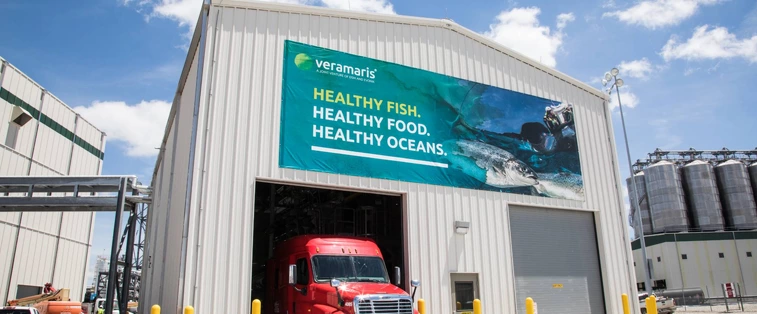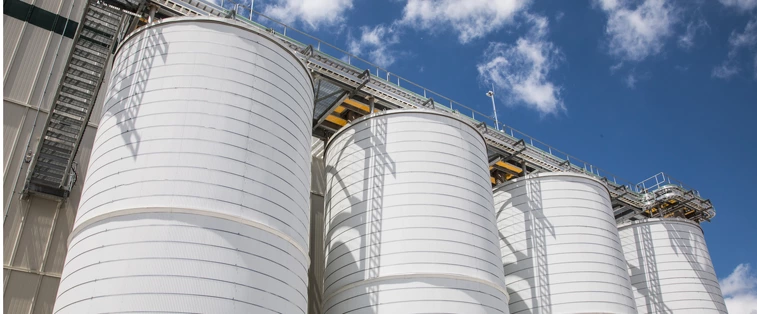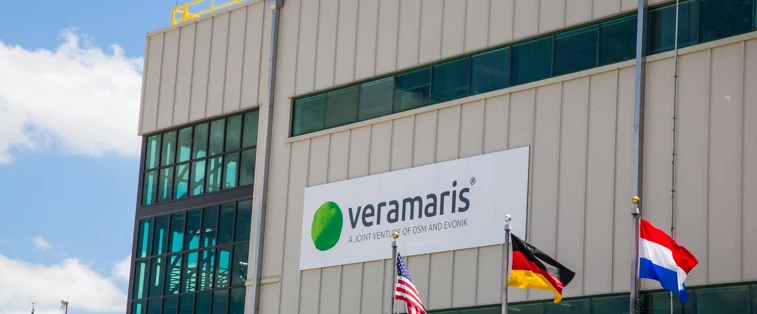


Unique facility begins production of omega-3 fatty acids for sustainable salmon farming
Following a construction period of just two years, a joint venture between Evonik and the Dutch company DSM has today commissioned its globally unique production plant in the US.
- World’s largest fermentative manufacturing using natural marine algae begins in Nebraska, USA
- Contributes to long-term sustainable animal nutrition and helps to conserve biodiversity in the oceans
- Strategic contribution to the further development of Evonik’s Animal Nutrition growth engine
- Investment volume of 200 million US dollars
Essen / Blair. Following a construction period of just two years, a joint venture between Evonik and the Dutch company DSM has today commissioned its globally unique production plant in the US. Through the fermentative manufacture of natural marine algae, the new plant produces a special algal oil that contains the key omega-3 fatty acids needed for healthy salmon farming.
The two parent companies of the 50:50 joint venture named Veramaris, have invested a total of 200 million US dollars in equal parts for the construction of the plant in Blair, Nebraska. The initial algal oil produced at the plant can sustainably supply approximately 15 percent of the annual demand the global salmon-farming industry has for the two omega-3 fatty acids EPA and DHA. The unique process developed by Evonik and DSM enables the manufacture of EPA and DHA for salmon feed for the first time without using any fish oil from wild-caught fish.
“In Veramaris, we have combined the competencies of two strong partners to make an innovative contribution to the healthy nutrition of the world’s growing population, without putting any further burden on our oceans,” says Christian Kullmann, chairman of the Executive Board of Evonik. Feike Sijbesma, CEO/Chairman DSM Managing Board commented: “I am pleased that together with Evonik we have reached a key milestone in turning the tide: through Veramaris, we are able to reduce the aquaculture industry’s reliance on the world’s finite fish oil resources for these vital omega-3 fatty acids. This fits perfectly with our purpose-led performance driven strategy, focused on addressing the world’s biggest challenges while simultaneously creating economic, environmental and societal value for all our stakeholders.”
With more than 40 production and R&D sites, North America represents a strategically important region for Evonik with high growth potential. In addition to the regional significance, this investment sees Evonik address one of the Group’s four strategic growth engines: Animal Nutrition. Apart from Animal Nutrition, the Group focuses its investments on Smart Materials, Specialty Additives, and Health & Care.
With Veramaris the Animal Nutrition business line has taken a significant step towards becoming an integrated and innovative system supplier of healthy and sustainable animal nutrition. The joint venture not only complements the portfolio of the business line; together with the business line’s activities in the precision livestock farming sector, it forms one of the most important pillars in the further development of Animal Nutrition.
The production of the Veramaris algal oil is based on the natural algae strain Schizochytrium, which DSM has brought to the partnership with Evonik. The joint development of the strain right up to commercial production, and the joint development of the process formed the basis for the new production plant. Evonik constructed the plant on site in Blair next to its existing facility, where it has been running a fermentation process to produce Biolys® (source of L-lysine) for many years now. The production complex benefits from many synergies in infrastructure, technology and personnel. In addition to this is the know-how Evonik has already gained over decades of large-volume fermentation at the Nebraska site.
Every year, 16 million metric tons of wild fish are caught to be used in the manufacture of fish meal and fish oil, which are then used as components in aquaculture feed. Through the addition of amino acids from Evonik and modern feeding concepts, the animal nutrition industry has already managed to significantly reduce the amount of fish meal used in fish feed. Now, the algal oil produced by Veramaris enables the reduction of the fish oil share without impacting the omega-3 fatty acid-content in the farmed fish.
This means that the Veramaris algal oil not only contributes to sustainable aquaculture but also supports healthy human nutrition. The omega-3 fatty acids EPA and DHA are essential fatty acids, contributing to brain, heart and eye health, which humans can only obtain via their food.
Company Information
Evonik is one of the world leaders in specialty chemicals. The focus on more specialty businesses, customer-oriented innovative prowess and a trustful and performance-oriented corporate culture form the heart of Evonik’s corporate strategy. They are the lever for profitable growth and a sustained increase in the value of the company. Evonik benefits specifically from its customer proximity and leading market positions. Evonik is active in over 100 countries around the world. In fiscal 2018, the enterprise with more than 32,000 employees generated sales of €13.3 billion and an operating profit (adjusted EBITDA) of €2.15 billion from continuing operations.
About Nutrition & Care
The Nutrition & Care segment is led by Evonik Nutrition & Care GmbH and contributes to fulfilling basic human needs. That includes applications for everyday consumer goods as well as animal nutrition and health care. This segment employed about 8,200 employees, and generated sales of around €4.6 billion in 2018.
Disclaimer
In so far as forecasts or expectations are expressed in this press release or where our statements concern the future, these forecasts, expectations or statements may involve known or unknown risks and uncertainties. Actual results or developments may vary, depending on changes in the operating environment. Neither Evonik Industries AG nor its group companies assume an obligation to update the forecasts, expectations or statements contained in this release.
